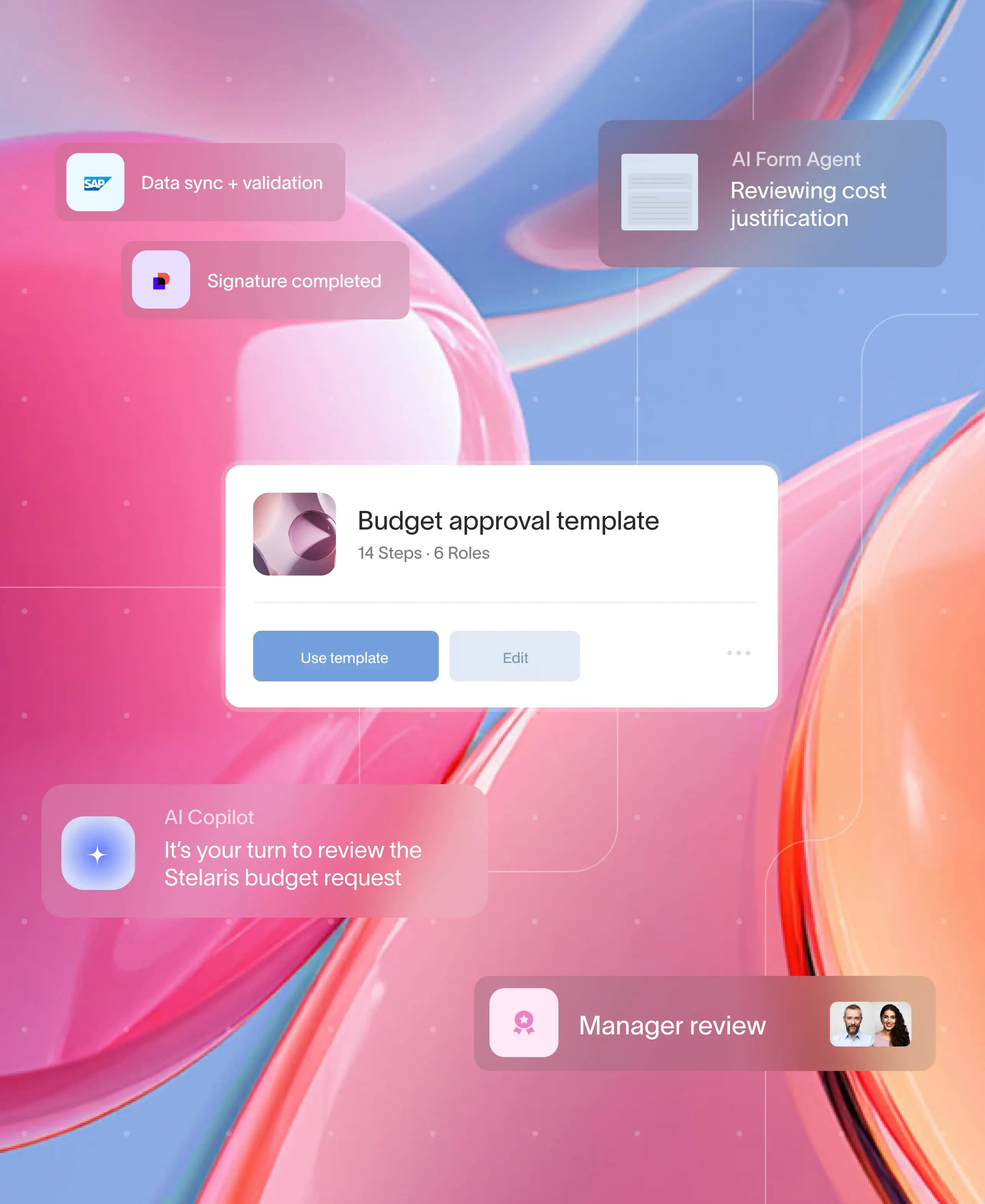
A digital workflow is a structured process of tasks, steps, and approvals carried out using computers and software, replacing traditional paper-based methods. With digital workflows, participants can instantly check project statuses, reducing delays caused by at any time, which shrinks the waiting time for emails or physical documents. To many, this is the simple answer to what is a digital workflow—it is a modern way to keep tasks visible, traceable, and less prone to manual errors.
The essence of a digital workflow goes beyond just going paperless. It ensures that the right people receive the right materials or information at the right moment. Instead of sifting through shared files in shared drives or email threads, you have one place that logs tasks, routes documents, and displays progress. This standardization reduces confusion, clarifies responsibilities, and ensures that every critical step is completed on time.
Many businesses prefer adopting digital workflows for their speed and transparency. Whether you are sharing contracts, processing invoices, or managing customer requests, the process becomes smooth when done digitally. Teams no longer waste valuable hours checking status updates because every change is recorded in real time. This efficiency is why so many organizations are replacing their legacy process in favor of connected, automated systems.
From paper to pixels: The leap to digital workflows
Manual processes once formed the backbone of everyday business operations. Stacks of folders, hours spent on repetitive tasks, and the constant risk of losing crucial files were the norm.. However, as demand for quicker turnaround increases, relying on paper or scattered spreadsheets hinders growth.. To remain competitive, industries are shifting from manual methods to digital workflows, which enhance accuracy and adaptability.
The transition often begins with one basic process. For instance, a department that previously mailed physical forms might decide to convert them into electronic documents. Over time, the efficiency gains from digital record-keeping prompt other teams to follow suit. Eventually, entire organizations embrace modern tools to keep projects visible and tasks assigned, leading to a broader cultural shift in how work is done.
This move from paper to digital also paves the way for deeper automation. Instead of merely replacing documents with online forms, businesses can adopt systems that automate digital workflow tasks behind the scenes. Time spent on manual sorting or forwarding of data is minimized, giving teams more freedom to take on challenging strategic responsibilities. As digital workflows become embedded, companies experience fewer errors, a more cohesive workforce, and faster completion rates.
How digital workflow automation changes the game
Digital workflow automation refers to the software-driven coordination of tasks, approvals, and communications so that stakeholders can operate without constant human intervention. Rather than emailing a teammate to request information or move a document forward, the system does it automatically once certain conditions are met. This eliminates bottlenecks, reduces oversight issues, and makes project execution faster and more consistent.
At its core, digital workflow automation is about removing predictable, repetitive steps from employees’ workloads. Instead of carefully watching each form or file, rule-based systems automatically route information and trigger alerts, allowing staff to focus on more strategic work. Over time, these systems can reveal patterns in productivity, allowing you to see which parts of the digital workflow process need attention or adjustment. Conducting a workflow analysis can help you identify gaps.
Today, digital workflow automation is used across industries — from customer service departments to financial firms and beyond. If someone scans an invoice, the software can pull relevant data, match it to an account, and send it to a designated queue. Implementing invoice automation can help the process. If additional verification is required, the system sends notifications to the right person. This blend of structure and clarity allows companies to maintain tight control of projects and keep them moving forward without constant manual nudging.
The big wins of a digital workflow process
A well-designed digital workflow process delivers tangible benefits to both staff and the organization.. By making tasks more transparent and structured, leaders avoid many of the frustrating bottlenecks that arise when too many manual steps are involved. Below are some advantages that can reshape how you handle operations.
Real-time visibility
In a manual system, tracking progress often involves searching through emails or calling colleagues. In a digital workflow, every step is automatically recorded and easily accessible. Anyone with permission can see who is doing what, which helps prevent lost files or duplicated efforts. This immediate insight tends to boost morale and keeps everyone aligned.
Reduced human error
When data is entered by hand or when tasks are managed using sticky notes, mistakes happen. Digital workflows reduce such errors by automating repetitive actions that are prone to mistakes. Instead of someone manually forwarding a document to the next department, the system can do it the moment a form is approved or a step is completed.
Smoother collaboration
Departments often trip over each other due to communication gaps. A digital workflow management platform fosters collaboration by linking relevant people and files in a single environment. Teams can exchange feedback, approve changes, and finalize tasks without the back-and-forth that often causes delays. Having an enterprise collaboration system further enhances this efficiency.
Scalable efficiency
As businesses grow, the volume of tasks, requests, or paperwork increases. A digital workflow adapts more quickly than a manual system. You can expand your processes, add new checkpoints, or revise existing ones without overhauling everything. This flexibility allows the workflow to evolve with your organization’s changing needs.
By showing clear returns on time saved and errors avoided, digital workflows often pay for themselves quickly. The more you rely on these automated methods, the more your staff can focus on high-value tasks. This lays a strong foundation for business growth and consistent, reliable service to your clients.
Simple steps to digitize your workflows
Building effective digital workflows starts with examining your existing tasks, then introducing automation in places where it can save time. Below is a practical roadmap to help you get started.
- Map out your current routine
- Set clear priorities
- Select the right platform
- Test and refine
1. Map out your current routine
Write down the steps you follow for a given process from start to finish. Pinpoint where files are created, where approvals happen, and who is involved. Many are surprised by how many mini-steps are tucked inside a single workflow. This level of detail helps you see exactly what can be automated or streamlined when you digitize your workflow.
2. Set clear priorities
Not every process needs to be automated at once. Look at which tasks are repeated most often or consume the most time. If you automate digital workflow activities that have predictable rules (like routing invoices to accounting) using an invoice approval workflow, you will quickly reduce errors. This approach allows you to make small, targeted gains before expanding to more complex processes.
3. Select the right platform
A variety of tools exist to handle digital automation and workflow tasks. Some are designed for finance departments, while others focus on customer support. Identify a solution that connects seamlessly with your existing software or one that can grow with your company. Make sure it has security protocols that match your industry’s standards, especially if you handle sensitive data.
4. Test and refine
Once you build a digital workflow, invite a few team members to run through it. Look for steps that feel clunky or create confusion. This pilot phase helps you to fine-tune the process before rolling it out to everyone. Ask for feedback on user experience, clarity of instructions, and whether the automation improved or complicated the process. Learning how to create a workflow will help in this step.
By following these steps, you can gradually digitize your workflow systematically rather than jumping in without a plan. Each time you refine a workflow, you gain valuable insights that help you optimize the rest of your operations. Over time, your organization develops a culture that values clarity, efficiency, and continuous improvement.
Tackling challenges in digital automation and workflow
Although digital automation and workflow solutions bring significant advantages, they are not without challenges. Here are some common challenges to watch out for and ideas on how to address them.
Employee concerns
Some workers worry that automation will replace their roles. To ease concerns, emphasize that automation is designed to handle repetitive tasks, allowing staff to focus on more meaningful, creative work. Offer thorough training and keep the lines of communication open. When staff feels prepared, they are more likely to welcome new processes.
Integration roadblocks
Companies often rely on several software tools that do not communicate well with each other. This can hamper your ability to build a seamless digital workflow. The solution is to choose platforms that have robust connectors or application programming interfaces. That way, data flows freely from one system to another without awkward workarounds.
Security and compliance
Handing off tasks to automated systems means storing more data in the cloud or on servers. This raises questions about encryption, data ownership, and regulatory compliance. Look for solutions that offer strong security features, user permission controls, and clear audit trails. You want the convenience of automation without introducing unnecessary risk.
By spotting these potential pitfalls, you can address them early and keep your transformation on track. When you navigate these hurdles successfully, your team gains confidence in the system. That paves the way for rolling out automation to a broader range of tasks across the organization.
Why Moxo is the key to digital workflow management
Many solutions promise to transform operations, but few combine simplicity and depth as effectively as Moxo. Its design is aimed at unifying clients, partners, and internal teams in a single environment that covers everything from approvals to project tracking. This unification is invaluable for digital workflow management in complex organizations.
First, with Moxo, all tasks, documents, and communications are centralized, eliminating the need to juggle multiple apps. This clarity reduces the friction that appears when each department uses different software. With Moxo, a finance team and a marketing team share a single hub where they manage projects, exchange updates, and store documents.
Second, Moxo allows for tailored automation paths to suit your business needs. You can define task responsibilities, set automated conditions, and manage how notifications are sent. Because Moxo is built to handle both simple and sophisticated workflows, it fits the needs of small teams and large enterprises alike — all while maintaining tight compliance standards.
Finally, Moxo focuses on security and trust. Encryption keeps sensitive data safe, while role-based access ensures only the right people see confidential files. For businesses that manage client relationships, this level of security helps maintain strong data protection. The platform’s flexibility and user-friendly layout make it an ideal springboard to scale your digital workflow automation efforts.
Get started with Moxo and watch your processes reach new levels of efficiency.
Conclusion
Digital workflows are no longer an optional upgrade. As industries grow more competitive, companies that stick to manual processes fall behind. By shifting to a digital workflow system, you streamline tasks and remove the guesswork that often causes costly delays. You also empower employees to devote their energy to complex or creative duties rather than repeating routine steps.
Organizations that embrace digital automation and workflow tools see faster completion times, clearer collaboration, and consistent results. The speed at which these benefits appear often surprises those who are new to automation. Once teams see the advantages firsthand, they start to look for even more areas that could benefit from a structured, digital workflow approach.
Get started with Moxo and watch your processes reach new levels of efficiency.
FAQs
How does digital workflow automation handle unexpected changes in a project?
Most platforms let you adjust rules or reassign tasks on the fly. If a project suddenly needs extra review, you can insert an additional approval step. While the system automates routine paths, it also allows manual overrides when an issue calls for a human decision. This keeps processes flexible enough to handle real-world surprises.
Do digital workflows require a major upgrade to existing hardware?
That depends on the scale of your transformation. Some cloud-based solutions run smoothly on standard hardware and with good internet access. You might not need high-end servers or complex setups unless you are handling massive data volumes or strict compliance standards. In many cases, basic upgrades like reliable network connections are enough to support a digital workflow.
How can we measure the impact of digital automation and workflow tools?
Common metrics include time saved, error rates, and overall project turnaround. By comparing these figures before and after automation, you see how much efficiency you gain. You may also track employee satisfaction or look at revenue changes if your workflow directly affects sales. Gathering these metrics over time shows whether your improvements are sustainable.
Is it possible to automate digital workflow steps that involve client signatures?
Yes. Many workflow platforms include e-signature capabilities or integrate with services that capture remote approvals. Once a client signs, the system updates the status automatically and notifies all relevant stakeholders. This eliminates the need to mail paper forms or scan signed documents. It also speeds up closing deals and finalizing contracts.
Can digital workflows aid in auditing and record-keeping?
Absolutely. A digital workflow creates a permanent record of who did what and when. This makes internal audits more transparent. If an external auditor needs proof of a specific step or document, you can retrieve that with a few clicks. Detailed logs also help if you ever need to trace a problem back to its source or verify compliance requirements.





